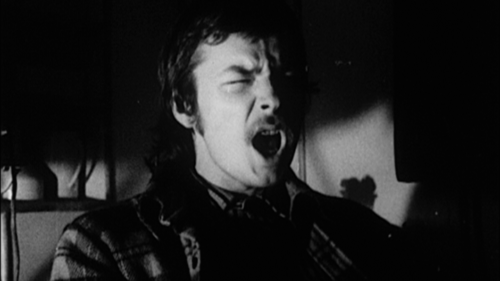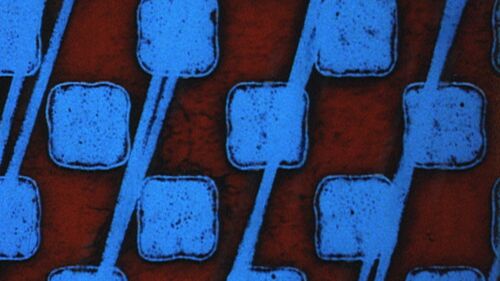
COME OUT
From out of a blurry image that slowly comes into focus we hear the sound of a sentence that shifts out of phase electronically until it becomes blurry and disappears, moving inversely to that of the image. The sound is the recording made by musician Steve Reich (the work from 1966) of a black prisoner speaking.
Argentina 1971 / 11:00 / Director: Narcisa Hirsch

THE BUBBLES
This work grew out of Knud Viktor’s private family recordings of his daughter blowing soap bubbles. Due to a cancellation from the intended composer, the film features Viktor’s first sound composition.
Denmark, France 1969 / 9:00 / Director: Knud Viktor

YYAA
The director of the film (appearing on the screen) is shouting YAAAH… The light comes from four sources being switched at random (this takes between 1 and 8 seconds) by an electronic device. Each light-change is accompanied by a different voice modulation of the speaker. The film technique makes it possible for the director to exhale for three minutes. The alternating close-ups and half-close-ups are totally unjustified.
Poland 1973 / 5:00 / Director: Wojciech Bruszewski

PERIODIC VIBRATIONS IN AN ELASTIC MEDIUM
Discrete images are modelled into a filmic form which grows out of visual kinetic linkages rather than linguistic modes, musical notions, mathematical constructs, or anecdotal concerns. Elimination of narrative sequences is suggestive of the concept of simultaneity, which is associated with painting and explored by the poetry of William Carlos Williams. The work is divided into three sections separated by pale blue passages. The title makes reference to Newton’s corpuscular theory of light. A continuing work composed from several thousand feet of film exposed since 1973 in a variety of geographical sites.
United States 1976 / 16:00 / Director: Janis Crystal Lipzin

ABC IN SOUND
This light-hearted experiment demonstrates differences in sound produced by arbitrary manipulation of the soundtrack. The optical soundtrack has been re-photographed to appear on the screen as the corresponding sound is heard. Missing for over 80 years, the film was found by BFI curators embedded in a reel of film that also contained Oskar Fischinger’s EARLY EXPERIMENTS IN HAND DRAWN SOUND.
Germany 1933 / 1:55 / Director: László Moholy-Nagy

DRESDEN DYNAMO
Dresden Dynamo is an abstract assault on the senses. Eschewing a camera, Rhodes affixed patterned Letratone stickers to the film itself and used filters to create red and blue colours. At the work’s core is an experimental approach to the stuff of film and a fiercely political outlook.
United Kingdom 1971 / 5:00 / Director: Lis Rhodes

MY MOVIE MELODIES
Picture is Sound <> Sound is Picture // A weaving reed / The fence of the temple / The fraying of the wire mesh / The water hyacinth / the sand of stars / play a melody. // We hear for the first time / The sound of the image itself
– Okuyama Jun’ichi
Japan 1980 / 7:00 / Director: Okuyama Jun’ichi

WINDOWS
Windows: intermediate states.
France 2004 / 8:48 / Director: Michèle Bokanowski

A GRAMMAR FOR LISTENING – PART 1
Over the centuries, Western culture has relentlessly attempted to classify noise, music and everyday sounds… Ordinary noises and the mundane sounds that are not perceived as either annoying or musical are of no interest. How then to create a meaningful dialogue between looking and listening? Luke Fowlers film cycle A Grammar for Listening (parts 1-3) attempts to address this question through the possibilities afforded by 16mm film and digital sound recording devices. In part 1, Fowler furthers his on-going dialogues with the sound artist Lee Patterson (Manchester, England). Parts 1 and 2 evolved from filming and recording trips, whose locations were chosen based on a number of geographic and acoustic possibilities.
United Kingdom 2009 / 22:00 / Director: Luke Fowler
